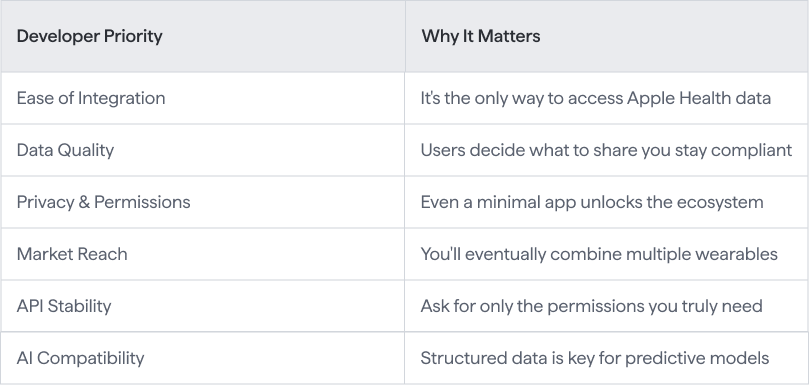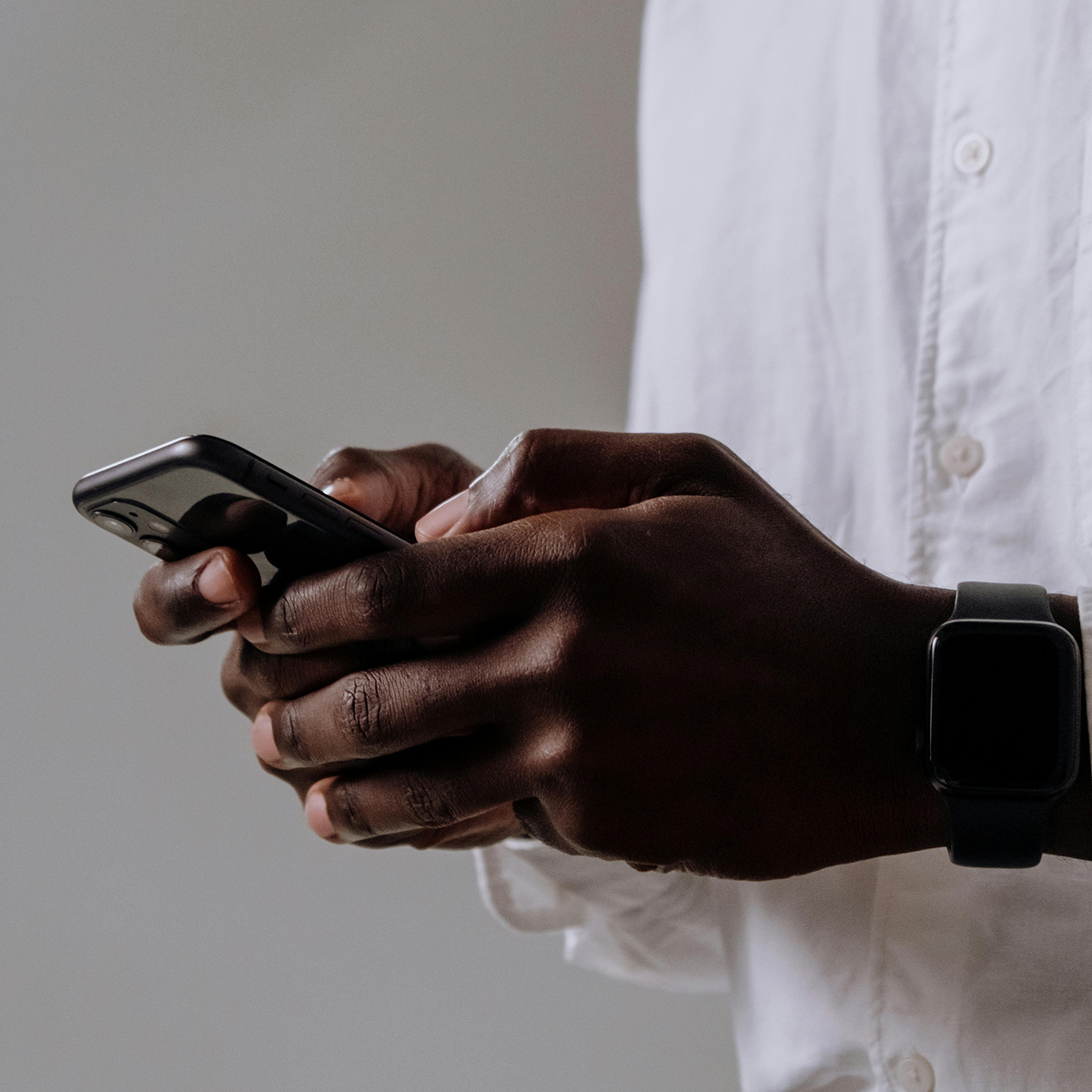Key Takeaways
- Apple Health requires native iOS apps. No web-only workarounds exist for accessing HealthKit data.
- Garmin provides deep athletic performance data. But integration complexity requires OAuth setup and data normalization expertise.
- Oura Ring and Whoop specialize in recovery tracking. Both have easier APIs (difficulty 28) compared to Fitbit.
- Multi-device integration takes 3-6 months without unified APIs. Standardized frameworks reduce this to weeks.
- Choose wearables based on your use case. Fitness apps prioritize Garmin, wellness apps favor Fitbit, longevity platforms need Oura Ring.
Is Your HealthTech Product Built for Success in Digital Health?
.avif)
Building a health or wellness app used to mean collecting data manually or asking users to log it themselves. Today, it means connecting directly to the devices people already wear — their Apple Watch, Fitbit, Oura Ring, or Garmin.
For users, this feels natural. For developers, it opens a world of opportunity. You can deliver personalized insights, detect early health risks, and make your product more engaging by using real-world data.
But which wearables are developers actually integrating — and why do they choose them?
This guide explores the most popular wearables in digital health, how developers use them, and what challenges each brings.
1. Why Wearable Integrations Matter More Than Ever
The global wearables market keeps growing every year. By 2030, it is expected to surpass $180 billion, driven by fitness, health monitoring, and preventive care.
More importantly, users expect apps to work seamlessly with their devices. If your app cannot sync steps, sleep, or heart rate, it feels outdated.
From a product perspective, wearable devices help you:
- Increase engagement by showing users progress and goals
- Improve personalization through real data
- Create new monetization opportunities (premium analytics, AI insights, recovery coaching)
- Enable preventive and remote care models
But developers quickly realize that each wearable ecosystem is different — technically, legally, and philosophically. Let’s explore what that means for health app development.
2. The Big Five in Health App Development
When we talk about wearable integrations in healthtech, five ecosystems dominate the space:
- Apple Health (and Apple Watch)
- Garmin Health
- Fitbit (now part of Google)
- Oura Ring
- Whoop
Let’s break down how each fits into the health app development ecosystem and what makes them valuable.
3. Apple Health: The Default Starting Point
Why Developers Love It
If your app targets iPhone users, Apple Health is the natural first step. It acts as a central hub that collects data from the Apple Watch and any other connected app.
Apple Health supports a wide range of metrics: activity, heart rate, sleep, mindfulness, blood pressure, and even lab results or medications.
From a developer’s point of view, HealthKit is stable, well-documented, and trusted by users.
What It’s Best For
- Lifestyle and wellness apps
- Fitness and activity tracking
- Sleep and mindfulness products
- Preventive health and coaching apps
Main Challenge
Apple Health is local-only. There is no backend API, so data stays on the user’s phone.
If you want to use it, you must build a native iOS app that reads data with the user’s consent and sends it securely to your server.
This makes Apple Health a mobile-first ecosystem — perfect for apps built around iOS but limiting for web-based products.
Key Insight
If you want to work with Apple Health data, your product needs a native app. There’s no shortcut.
But if you get it right, you can access the richest, most complete source of wearable data in the world.
%20-%20visual%20selection%201.png)
Visual chart or comparison of the five most popular wearable technology platforms Apple Health, Garmin, Fitbit, Oura Ring, and Whoop detailing why developers choose to integrate their data into digital health apps.
4. Garmin: The Athlete’s Choice
Why Developers Love It
Garmin is popular among serious athletes and endurance enthusiasts. Its devices collect detailed performance data such as VO₂ max, cadence, heart rate zones, training load, and recovery time.
The Garmin Health API allows developers to access both historical and real-time data. It’s especially useful for sports tech, rehabilitation, and corporate wellness applications.
Garmin users are loyal and data-driven, which makes them valuable for long-term engagement.
What It’s Best For
- Sports and training apps
- Performance optimization tools
- Injury prevention and recovery programs
- Corporate wellness and employee fitness
Main Challenge
Garmin’s API is more complex than consumer platforms like Fitbit. It requires an application process, OAuth setup, and server-to-server integrations.
It also has its own data formats that must be normalized if combined with data from other brands.
Key Insight
Garmin is ideal if your users are athletic or highly active. The data depth is excellent, but integration takes time and planning.
5. Fitbit: Still the Most Popular Mainstream Wearable Device
Why Developers Love It
Fitbit has one of the largest user bases in the world. Since being acquired by Google, it has gained tighter integration with Android and Google Fit.
The Fitbit Web API lets developers access daily activity, heart rate, sleep, and nutrition data. It is easy to integrate and perfect for MVPs or early-stage apps.
What It’s Best For
- General fitness and lifestyle apps
- Wellness and weight management
- Step challenges and gamified experiences
Main Challenge
Fitbit’s ecosystem is shifting under Google’s ownership. Some features are now moving toward Google Fit or Google’s Health Connect. Developers need to stay updated to avoid disruption.
Also, Fitbit data tends to be more “consumer-grade” than Garmin’s or Oura’s, so it’s less suited for professional or clinical use.
Key Insight
Fitbit is still a great entry point for health app development teams who want fast integration and large market reach but the future may lean more toward Google Health Connect as the unified standard for Android users.
{{lead-magnet}}
6. Oura Ring: The Sleep and Recovery Specialist
Why Developers Love It
Oura Ring is famous for its accuracy in tracking sleep, recovery, and readiness. It provides metrics such as HRV, resting heart rate, sleep stages, and temperature trends.
The Oura Cloud API allows developers to pull this data for analysis or combine it with other metrics.
Oura has built strong partnerships with wellness, longevity, and women’s health brands that use its data for advanced insights.
What It’s Best For
- Sleep optimization
- Longevity and biohacking apps
- Women’s health and hormone tracking
- Stress and recovery analysis
Main Challenge
Oura’s API is available but somewhat limited compared to developer-friendly platforms like Fitbit. Access to some metrics requires business-level partnerships.
Oura’s focus on privacy means you need clear user consent and careful data management.
Key Insight
Oura’s data quality is high and trusted by researchers, but it’s not ideal if you need open, high-frequency data streams. It shines when you focus on personalized recovery or sleep-based insights.
7. Whoop: The Coach’s Favorite
Why Developers Love It
Whoop focuses on recovery, strain, and performance. Its audience includes athletes, trainers, and health-conscious professionals.
The Whoop Developer Platform provides access to strain scores, sleep, HRV, and recovery data. It integrates well with fitness and coaching platforms.
What It’s Best For
- Coaching and performance apps
- Team training dashboards
- Recovery tracking and athlete monitoring
Main Challenge
Whoop’s API is newer and not yet as mature as Garmin’s or Fitbit’s. Some data is restricted or delayed, and developers often need to work through official partnerships.
Key Insight
Whoop is a great choice if your users value guidance over raw data. It focuses on insights rather than metrics and is often used to power coaching recommendations.
8. Social Layer for Wearable Data
Strava is not a hardware device, but it is one of the most important data ecosystems in fitness. Many devices — Garmin, Fitbit, Whoop — sync data directly into Strava.
Developers can use the Strava API to access activity data, routes, and segments, making it a strong companion for social and competitive apps.
Best For
- Fitness and endurance apps
- Group challenges and community platforms
- Corporate wellness and team activities
Key Insight
Strava adds a social dimension to otherwise isolated health data. It’s the best option for building community features and motivation loops.
9. How Developers Combine Devices
In the real world, users often have more than one wearable. A runner may use Garmin for training, Oura Ring for recovery, and Strava for social tracking.
Developers who want to give a complete view of health need to merge this data into a single, unified format.
That is where most health apps hit their biggest challenge: fragmentation.
Each API has different authentication, data models, and rate limits. Building and maintaining six different integrations can take months and ongoing maintenance can consume your entire roadmap.
This is why unified APIs and data standardization frameworks are becoming critical for health app development. They allow developers to integrate multiple wearables once and focus on building value.
10. What Developers Look For in a Wearable Integration
Across all the brands, the same themes appear when talking to developers:

When planning your product roadmap, think about these priorities before choosing which wearables to support. A strong data foundation early on saves enormous effort later.
11. The Future: Unified, AI-Ready Health Data
The wearable device landscape is growing faster than developers can keep up. Every new device brings new data types, new formats, and new APIs.
The next generation of mobile health apps will rely on interoperability. Instead of building one integration at a time, they will plug into unified frameworks that provide standardized, privacy-safe access to multiple wearables through one API.
These frameworks also prepare data for AI and analytics, allowing startups to build smarter insights faster.
Open Wearables is one example of this direction — an open-source infrastructure that lets developers connect Apple Health, Garmin, Fitbit, Oura Ring, Whoop, and Strava with a single unified data model.
The result: faster development, cleaner data, and AI-ready foundations for personalized health experiences.
12. Key Takeaways
If you are planning your wearable integration strategy, remember:
- Start with Apple Health for iOS users — but be ready to build a native app.
- Add Garmin if your audience includes athletes or sports professionals.
- Use Fitbit or Google Fit for broad consumer reach.
- Include Oura Ring for recovery and sleep intelligence.
- Consider Whoop for training and coaching scenarios.
- Leverage Strava for community and motivation.
- Everyone underestimates integrations. You’ll burn months just getting OAuth + normalized sleep data if you’re not prepared.
Most importantly, plan for interoperability from the beginning. Users will bring their own devices. Your product should be ready to speak their language.
13. Conclusion: Build Once, Connect Everywhere
The wearable device ecosystem is powerful but fragmented. Each device has its own story, audience, and API.
For health app development teams, the key is not to choose one over another but to build flexible systems that can connect to all of them.
Unified health APIs make that possible. They save time, reduce technical debt, and allow your team to focus on creating experiences users love instead of managing integrations.
The future belongs to apps that can connect, interpret, and act on data not just collect it.
Frequently Asked Questions
The most commonly integrated wearable devices in healthcare are the Apple Watch, Fitbit, Garmin, Oura Ring, and Whoop. Developers choose them because of their mature APIs, reliable sensor data, and large user base. These healthcare wearables provide continuous data on heart rate, sleep, and recovery that can be securely integrated into mobile health apps.
The choice depends on available metrics, data accessibility, and developer tools. For example, Apple HealthKit and Fitbit Web API offer broad compatibility and documentation, while Garmin Health API and Oura Cloud API provide more detailed physiological metrics. The best wearable SDK for healthcare apps balances data depth, privacy compliance, and ease of integration.
Integration typically uses wearable APIs or SDKs that sync data through cloud endpoints or direct Bluetooth connections. Developers normalize incoming data using standards like FHIR or Open mHealth to maintain consistency across multiple wearables. Secure architecture, encryption, and consent management are essential to comply with HIPAA and GDPR.
The main difficulties are fragmented wearable data formats, inconsistent update frequencies, and different authentication methods across APIs. Developers must unify heart rate, HRV, and sleep data into one schema, often using middleware or unified APIs to standardize wearable health data for analysis and visualization.
No — most wearable technology APIs are not automatically HIPAA-compliant. Compliance depends on how your app handles, stores, and transmits data. Developers must use HIPAA-ready infrastructure, encrypted cloud storage, and Business Associate Agreements (BAAs) when working with protected health information (PHI) from wearable health monitoring devices.
FHIR provides a consistent framework for structuring and sharing health data between wearable devices and electronic health records. By mapping wearable data to FHIR resources (like Observation or Patient), developers can make health apps interoperable with clinical systems and scalable across the healthcare ecosystem.
Once wearable data is standardized, AI wearables and analytics models can detect patterns in recovery, physical activity, and cardiovascular trends. This helps healthcare providers deliver personalized interventions and enables startups to turn passive data collection into predictive healthcare insights.
To prepare for new devices and standards, developers should design modular APIs, use open-source health data connectors (like Momentum’s FHIR MCP Server), and avoid hardcoding logic for a single vendor. This ensures that the app can easily integrate the next generation of smart wearable technologies without major rewrites.











.png)

.png)


.png)
%20Do%20With%20Apple%20HealthKit%20Data.png)



.png)